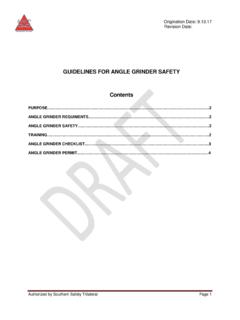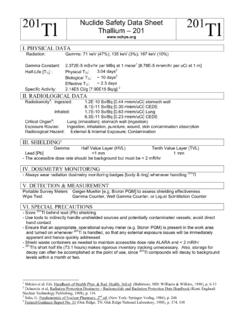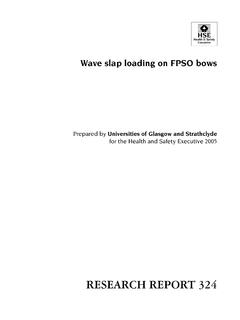Transcription of OFFSHORE TECHNOLOGY REPORT 2001/013
1 HSEH ealth & SafetyExecutiveLoadsOFFSHORE TECHNOLOGY REPORT2001/013 HSEH ealth & SafetyExecutiveLoadsEdited under the HSE Technical Support Agreement by BOMEL LtdLedger HouseForest Green RoadFifieldMaindenheadBerkshireSL6 2 NRHSE BOOKSii Crown copyright 2002 Applications for reproduction should be made in writing to:Copyright Unit, Her Majesty s Stationery Office,St Clements House, 2-16 Colegate, Norwich NR3 1 BQFirst published 2002 ISBN 0 7176 2385 8 All rights reserved. No part of this publication may bereproduced, stored in a retrieval system, or transmittedin any form or by any means (electronic, mechanical,photocopying, recording or otherwise)
2 Without the priorwritten permission of the copyright REPORT is made available by the Health and SafetyExecutive as part of a series of reports of work which hasbeen supported by funds provided by the the Executive, nor the contractors concernedassume any liability for the reports nor do theynecessarily reflect the views or policy of the CONTENTS Page No FOREWORD v 1 INTRODUCTION AND SCOPE 1 Source of Information 1 Effects of Loads 1 2 DEAD LOADS 3 3 IMPOSED LOADS 5 4 HYDROSTATIC LOADS 7 5 ENVIRONMENTAL LOADS 9 Wind
3 9 Waves and Current 10 Marine Growth 20 Snow and Ice 20 Combinations of Environmental Parameters for Design 21 6 DEFORMATION LOADS 23 7 ACCIDENTAL LOADS 25 General 25 Vessel Collision 25 8 LOADS IN COMBINATION 27 General 27 Extreme Conditions 27 Operating Conditions 27 Accident Conditions 27 9 OPERATIONAL DATA (LOADS)
4 29 10 REFERENCES 31 iv v FOREWORD This document provides technical information previously contained in the Fourth Edition of the Health and Safety Executive s OFFSHORE Installations: Guidance on Design, Construction and Certification (1990 edition plus amendments)(1). The Guidance was originally published in support of the certification regime under SI289, the OFFSHORE Installations (Construction and Survey) Regulations 1974(2). However, SI289 was revoked by the OFFSHORE Installations (Design and Construction, etc) Regulations, 1996, which also introduced the verification provisions into the OFFSHORE Installations (Safety Case) Regulations, 1992.
5 The Guidance was formally withdrawn in its entirety on 30 June 1998 (see HSE OSD Operations Notice 27(3)). The withdrawal of the Guidance was not a reflection of the soundness (or otherwise) of the technical information it contained; some sections (or part of sections) of the Guidance are currently referred to by the OFFSHORE industry. For this reason, after consultation with industry, relevant sections are now published as separate documents in the HSE OFFSHORE TECHNOLOGY (OT) REPORT series.
6 It should be noted that the technical content of the Guidance has not been updated as part of the re-formatting for OTO publication, although prescriptive requirements and reference to the former regulatory regime have been removed. The user of this document must therefore assess the appropriateness and currency of the technical information for any specific application. Additionally, the user should be aware that published sections may cease to be applicable in time and should check with Operations Notice 27, which can be viewed at , for their current status.
7 Vi 1 1. INTRODUCTION AND SCOPE SOURCE OF INFORMATION This OFFSHORE TECHNOLOGY (OT) REPORT provides technical information on loads and their assessment for OFFSHORE Installations. It is based on guidance previously contained in Section 15 of the Fourth Edition of the Health and Safety Executive s OFFSHORE Installations: Guidance on Design, Construction and Certification (1) which was withdrawn in 1998. As discussed in the Foreword, whilst the text has been re-formatted for OFFSHORE TECHNOLOGY publication, the technical content has not been updated.
8 The appropriateness and currency of the information contained in this document must therefore be assessed by the user for any specific application. EFFECTS OF LOADS The principal categories of load are: Dead loads Imposed (operational) loads Hydrostatic loads Environmental loads Deformation loads Accidental loads. Static, dynamic and fatigue effects of loads may need to be considered depending on the variation of the load with time and on the response characteristics of the structure.
9 2 3 2. DEAD LOADS Dead Loads are fixed gravitational loads that can be varied significantly only by major alterations to the structures and / or the installed equipment. They comprise: The weight in air of the entire structure including all secondary structures, and the weight of all equipment and machinery installed on the Installation. Those gravitational loads imposed by conductors, risers and any other normally fixed items that do not directly form part of the Installation but which are supported by, and transfer loads to, the Installation.
10 4 5 3. IMPOSED LOADS Imposed loads include all loads related to the operational use of the Installation. They are inherently variable in magnitude and / or disposition and, in certain cases, they have major horizontal components. Imposed loads include: Loads arising from the functional activities of the Installation eg. drilling, production and storage operations, helicopters landing and taking off, and loads arising from the transfer of persons and stores by the use of cranes or other means.














